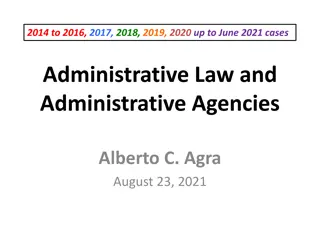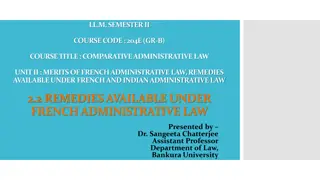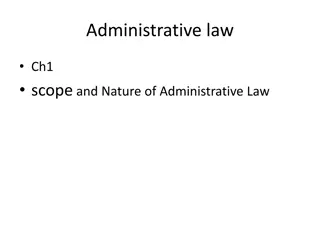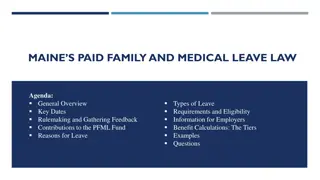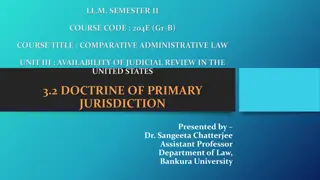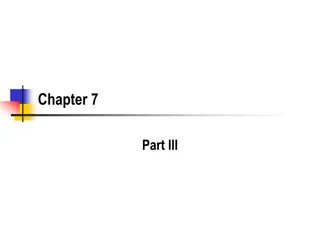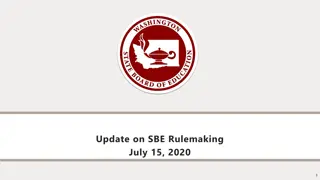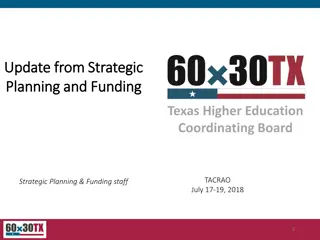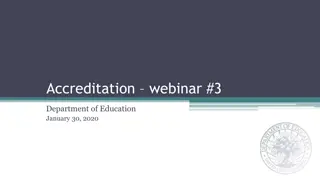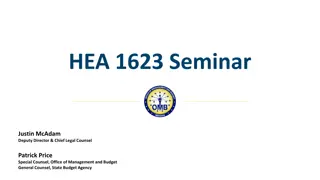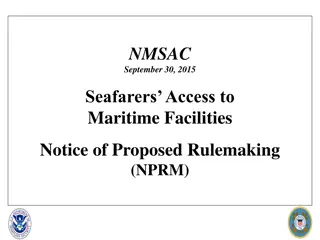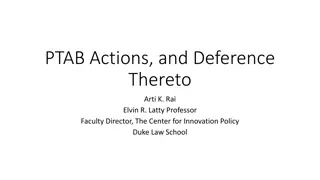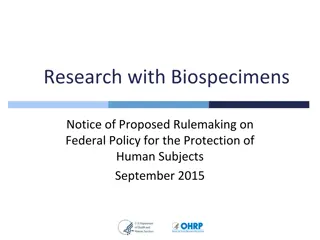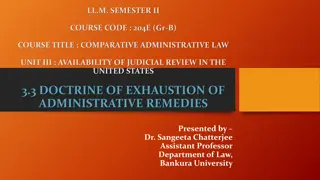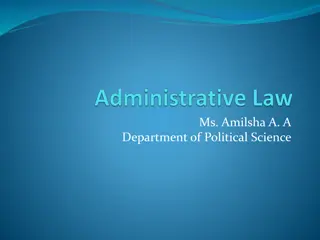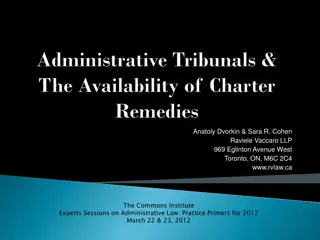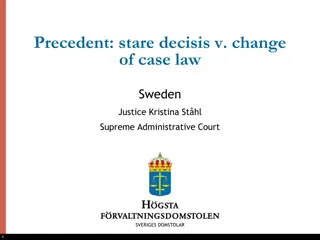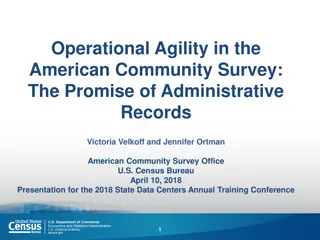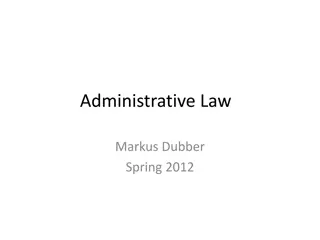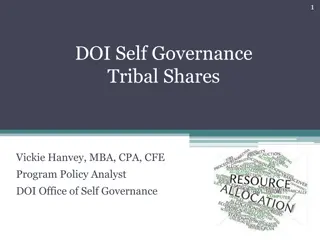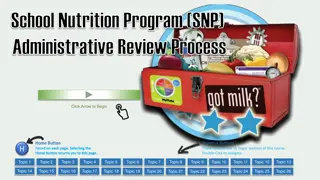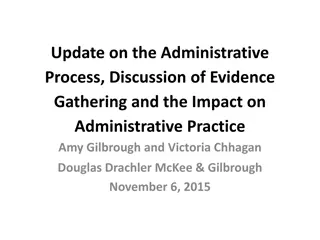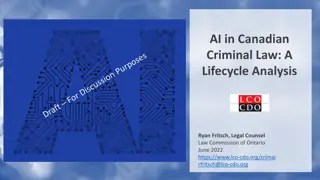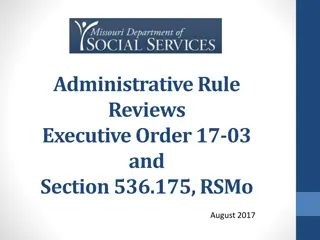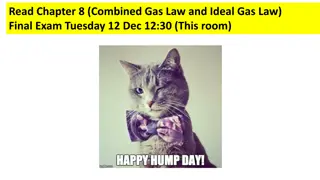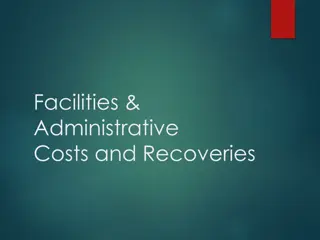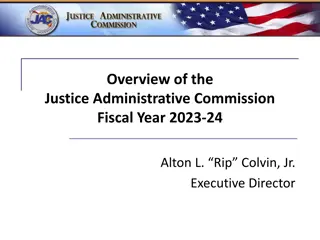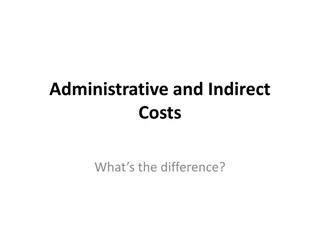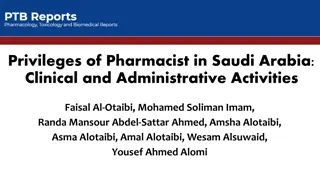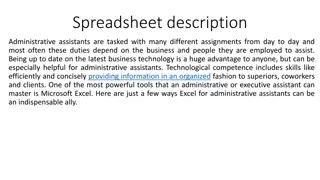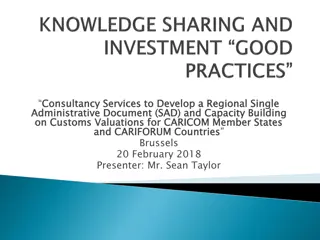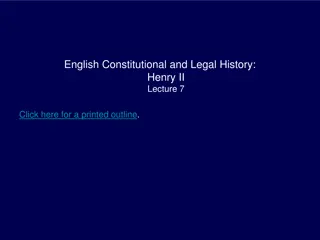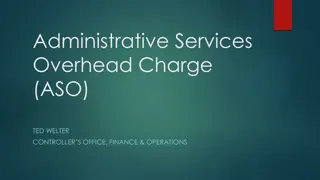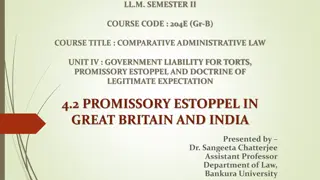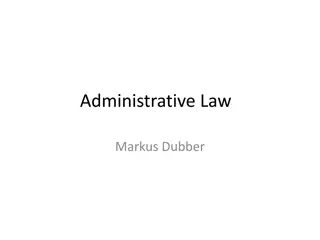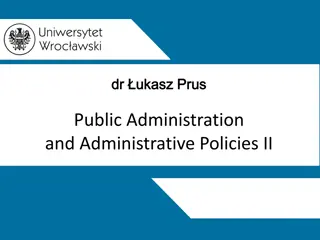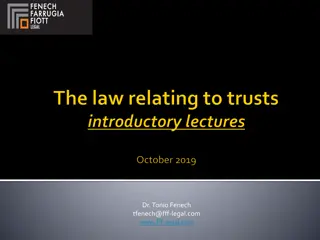Rulemaking Process in Administrative Law
Exploring various aspects of the rulemaking process in administrative law, including instances where agencies may need to re-notice revised rules, changes made to rules based on feedback, challenges in commenting on new proposals, and the importance of transparency in disclosing technical information underlying regulations.
Download Presentation

Please find below an Image/Link to download the presentation.
The content on the website is provided AS IS for your information and personal use only. It may not be sold, licensed, or shared on other websites without obtaining consent from the author. Download presentation by click this link. If you encounter any issues during the download, it is possible that the publisher has removed the file from their server.
E N D
Presentation Transcript
When Do You Need To Re-Notice a Revised Rule? What if the agency realizes when reading the comments that it needs to change the rule? EPA did this in the Regulators when it abandoned the direct regulation of integral vistas. 2
Chocolate Manufacturers Assn v. Block, 755 F.2d 1098 (4th Cir. 1985) What is WIC? The initial notice was for a rule to regulate WIC payments for breakfast cereals with high sugar content. How was the final rule different from the proposed rule? What new product was added to the regulation? 3
The Notice Problem CMA claimed that it was denied the opportunity to comment on the inclusion of chocolate milk. What was the agency defense? Was the rule about cereal, or was it about sugary breakfast food? Is chocolate milk a logical outgrowth of sugary cereal? The agency had to re-notice the rule. What should the CMA do if the new proposed rule affects them? 4
Limits on Logical Outgrowth - Arizona Public Service Co. v. E.P.A. EPA publishes a proposed rule that gives Indian tribes the same regulatory rights as states. State plans are subject to state court judicial review Why did the tribes object to this in comments? How was the rule changed? What was the claim by plaintiffs? How did the court analyze the problem? Why shouldn't the change have been a surprise? 5
What about Technical Information Underlying the Rule? (not in book) Portland Cement v. Ruckelshaus, 486 F2d 375 (1973) The agency must disclose the factual basis for the proposed rule, if it relied on scientific studies or other collections of information. Connecticut Light and Power v. NRC, 673 F2d 525 (1982)? The agency cannot hide technical information. Why is this a big deal in environmental regs? What are the potential downsides of this policy? 6
Additions to the Published Record - (not in book) Gold mining under the CWA. EPA added 6000 pages of supporting info when responding to comments. The agency may supplement the rulemaking record in response to comments asking for explanation. The question is whether the information was critical to evaluating the rule for comments. Rybachek v EPA, 904 F.2d 1276 (1990) 7
Setting a Threshold for Enforcement Bug parts are regulated as adulterants. (They do not go on the label.) There is no statutory standard for bug parts in candy bars. The FDA issues a policy statement that it will not take enforcement actions against candy bars unless they have more than 5 insect parts per bar. Is this a stealth rule? 8
Does it bind anyone? If you are a manufacturer, should you have bug parts in your candy bar at all? When might you challenge it? (Ripeness) But what if you represent Consumers Disgusted by Bug Parts, Inc.? What is your argument that this is really a rule? What do you know about what is in you candy bar? Community Nutrition Institute v. Young, 818 F.2d 943 (D.C. Cir. 1987) 9
When Does an Incentive Become Coercion? DOL made a policy statement that it would reduce inspections of workplaces that adopted an OSHA suggested safety plan that exceeded federal minimums. Is this really voluntary? What does it cost if you do not do a safety plan? Does coercion make this a binding rule? Chamber of Commerce v. U.S. DOL, 174 F.3d 206 (D.C. Cir. 1999) 10
Inspection or Prosecution Guidelines OSHA adopts a plan for deciding which employers to inspect based on the risk in the industry. A selected employer contests the rule, saying that OSHA inspections are expensive and time consuming, thus this has a substantial impact. Is this a successful argument? How is this different from the coercion case? Again, the question is whether it changes rights or duties. 11
Are Compliance Plans Stealth Rules? A compliance plan is a corporate document that outlines how a company tries to assure that it complies with the law. DOJ issues guidance that a corporate compliance plan for antitrust laws will count as mitigation under the Sentencing Guidelines for criminal antitrust claims. Does it affect law abiding companies? 12
Substantial Impact Test for Procedural Rules The Department of Health and Human Services changed the method by which home health providers could obtain reimbursement for expenses under the Medicare Program. In particular it required that they submit their requests in a new format and to regional intermediaries, rather than to HHS directly. How did plaintiffs argue that this was a legislative rule, rather than a procedural rule? What is the impact on them of the change? 13
Procedural Rules and Policy Statements Wrap-up Same analysis as substantial impact or legally binding test for substantive rules. What is the actual impact on your client? Will compliance costs significantly increase Medicare case? Does it change their legal options shortened period to reply to complaint? Does it actually change substantive requirements requiring new information for a benefit determination? We will revisit this when we look at standing. 14
Interpretive Rule or Legislative Rule Wrap Up Does it force regulated parties to change their actions? Does the agency treat it as binding? Does it allow exceptions? Is it necessary to enforce the statute? List of pollutants, for example. Does it provide specific details which limit the action of regulated parties? 15
Publishing Legislative Rules that do not need Notice and Comment APA 552(D) Publication in the FR (D) substantive rules of general applicability adopted as authorized by law, and statements of general policy or interpretations of general applicability formulated and adopted by the agency; and What if the agency does not publish the document in the FR, but puts it on the Internet? (Which has become very common.) Except to the extent that a person has actual and timely notice of the terms thereof... 16
When Notice and Comment Does Not Make Sense APA 553 (b)(3)(B) when the agency for good cause finds (and incorporates the finding and a brief statement of reasons therefor in the rules issued) that notice and public procedure thereon are impracticable, unnecessary, or contrary to the public interest. 17
Actions where Secrecy is Important Wage and price controls Bidding on contracts Negotiations on land purchases and sales 18
Emergencies and Impracticality Emergency Rules http://www.doa.la.gov/Pages/osr/emr/emr.aspx Misused in LA and most states This GAO Report indicates that the feds may also misuse this exception. Interim Final Rules Published and in effect, but will be modified after comments are in. 19
Time Constraints The GAO found that agencies frequently skip notice and comment when they have to make a rule with a short timeframe. Usually statutory deadlines, or a version of emergencies. Classic would be hunting seasons. How would this have helped in the Regulators? How did notice and comment improve the rule? Should the agency be able to use this exception if it delayed the rulemaking? 20
Technical Corrections Calculations and other non-discretionary rules Technical corrections Can require notice and comment if the correction causes a different result. Theory is that these are mechanical and thus notice and comment would not add any new information. 21
What is Formal Rulemaking? A rulemaking conducted as a trial type hearing The agency support for the rule must be presented at the hearing Interested parties may present and cross-examine evidence History - grew out of rate making in the early 20th century. Rate making affects a small number of parties The courts thought they should get due process 22
Why avoid formal rulemaking? The peanut hearings (FDA must do formal rulemaking in some situations) Should peanut butter have 87 or 90% peanuts? 10 years and 7,736 pages of transcript What was the concern in Shell Oil v. FPC? Formal rulemaking was impossibly time consuming to use for regulating something changeable such as natural gas rates. Why does just getting the right to be heard at a formal hearing benefit parties that oppose a rule? 23
When is Formal Rulemaking Required? Disfavored by the modern courts Must have magic statutory language or be required by the agency's on rules Only when rules are required by statute to be "made on the record after opportunity for an agency hearing" Lawyering tip When would you want to argue that formal rulemaking is required? What do you have to do to support your request? 24
Negotiated Rulemaking The negotiation is between interest groups and the agency to develop a rule that will then go through notice and comment. The objective is to identify problems and try to find compromises before the notice and comment process. The negotiated rule has to be supported and noticed through the regular APA process. The representation problem is that some disadvantaged groups may be left out. 25
Are there Constitutional Due Process Rights in Rulemaking? What does the DC circuit want the NRC to do to improve the due process in their rulemaking? it likewise clearly thought it entirely appropriate to "scrutinize the record as a whole to insure that genuine opportunities to participate in a meaningful way were provided The court wants more public participation than the APA requires. Vermont Yankee Nuclear Power Corp. v. NRDC, 435 U.S. 519 (1978) 26
The Role of the APA Did the rulemaking comply with the APA? What is the lower court's theory about the APA requirements? Floor or ceiling? Who does the court think should decide on the appropriate procedures? Does this look like Goldberg or Matthews? 27
The Substantive Issue The DC court's real problem with the rulemaking was that the NRC s wanted to take the nuclear waste problem out of the review by a rule. Can an agency put off a problem by assuming that a solution will be found in the future? We are 40+ years latter - who was right about the waste disposal problem? 28
The United States Supreme Court The APA controls courts cannot add more procedure. "The fundamental policy questions appropriately resolved in Congress and in the state legislatures are not subject to reexamination in the federal courts under the guise of judicial review of agency action. Time may prove wrong the decision to develop nuclear energy, but it is Congress or the States within their appropriate agencies which must eventually make that judgment. Why is this critical for the political control of agencies? 29
Ex Parte Communications and Political Influence Why is the ex parte problem different in rulemaking than in adjudication? Do ex parte contacts matter in rule making? Traditional view - rulemaking is open to all, so there are no ex parte contacts. 30
Home Box Office, Inc. v. FCC Regulation of advertising and program content on cable Lots of contacts with FCC commissioners Court says it is a big problem if info is left out of the record You do not need to put in contacts before the rule is promulgated Decisionmakers should not talk to outsiders during the review period after publication, and should document it if they do. 31
Sierra Club v. Costle Sierra Club claimed senator Bird from West Virgina coerced the EPA on coal burning power plant standards Why would Senator Bird care about this? What should Congress do if it does not like ex parte contacts in rulemaking? What is the key test when looking at the record? 32
Volpe Test The Volpe test for whether a rulemaking may be overturned solely on evidence of Congressional pressure. 1) was there specific pressure on the agency to consider improper factors? 2) did the agency in fact change its mind because of these improper facts? 3) was this put in the register so the public could challenge it? 33
What did the Court Rule when it applied Volpe to this Case? No problem with the contacts because Congress should be involved in such policy decisions What if Byrd said he could cut off funding to the agency and get everyone fired? Doesn t matter as long as the agency has a proper basis for the rule. 34
What is the president's role in rulemaking? Controls and supervises executive branch decisionmaking How is the role different in adjudications? When should the president's contacts be documented? When the statute requires that they be docketed If the rule is based on factual information that comes from such a meeting. 35
Bias and Prejudgment Remember the cases on bias of decisionmakers in adjudications? Should these also apply to rulemaking? 36
Association of National Advertisers , Inc. v. FTC FTC is adopting rules on TV advertising directed at children Chairman has written and spoken at length on the evils of TV ads aimed at children Plaintiffs seek to disqualify him because of bias What happened in Cinderella? Cinderella disqualified the same Chairman from participating in an adjudication because he had prejudged some of the facts. 37
Is the Standard Different for Rulemaking? Clear and convincing evidence that he has an unalterably closed mind on matters critical to the rulemaking. 38
Can the court make this an Adjudication? The Court said there were aspects of an adjudication to this rule making because there was a limited statutory right of cross examination. Rejected because modifications of rulemaking procedures do not make them adjudications. 39
What were the Commissioner's Comments? Discussion and advocacy What is it going to take to disqualify an agency head from a rulemaking? Charlton Heston as head of BATF? 40
Regulatory Review and Cost Benefit Analysis Next Time Have a good break! 41


